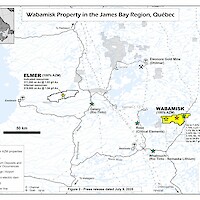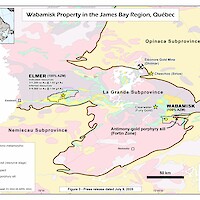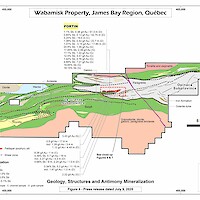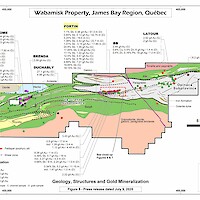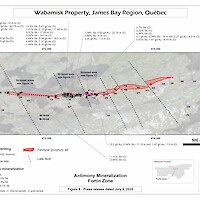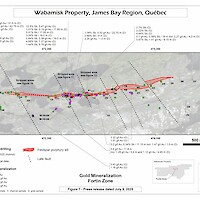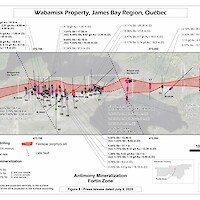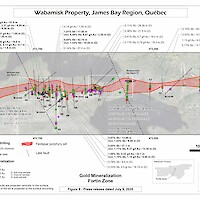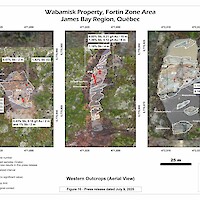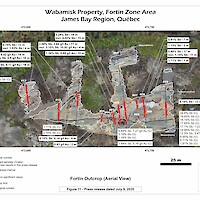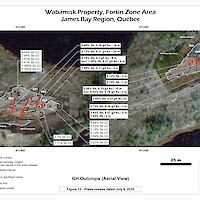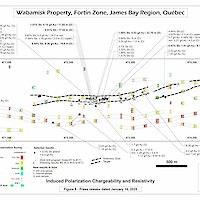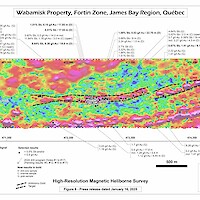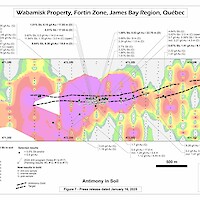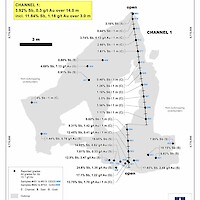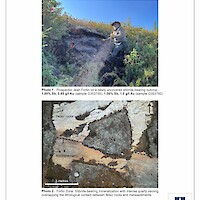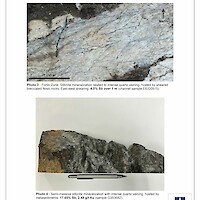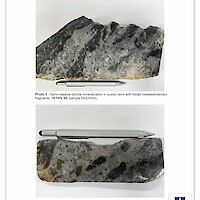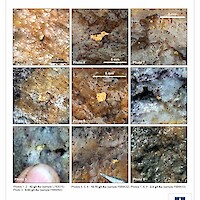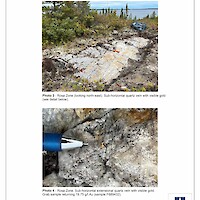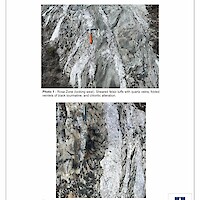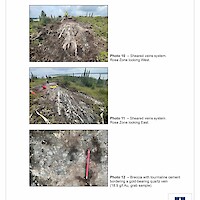2025 - Follow-up Program to Further Delineate the Fortin Zone
In preparation for the 2025 drill program, Azimut completed mechanical surface stripping and extensive channel sampling during the summer along the Fortin Zone. All 6 stripped areas, collectively covering 350 metres along a 1.5-kilometre east-west strike, exposed the feldspar porphyry sill and host metasediments, supporting the geometric continuity of the mineralized system.
The best results included:
- WR25-01: 3.24% Sb / 19.0 m incl. 4.02% Sb / 15.0 m. Peak value of 13.4% Sb / 1 m
- WR25-02: 2.08% Sb, 2.64 g/t Au / 17.0 m incl. 3.15% Sb, 10.92 g/t Au / 4.0 m. Peak value of 36.5 g/t Au / 1 m.
- WR25-12: 1.66% Sb, 0.42 g/t Au / 14.0 m incl. 2.31% Sb, 0.50 g/t Au / 10.0 m. Peak value of 4.29% Sb / 1 m.
- WR25-13: 0.97% Sb, 0.17 g/t Au / 16.0 m. Peak value of 2.36% Sb / 1 m.
High-grade gold (up to 36.5 g/t Au over 1 m in channel WS25-02) associated with antimony was also uncovered further supporting that the gold potential of the Fortin Zone may increase at depth, a pattern already observed in other antimony-gold deposits worldwide.
2025 Drill Program Goals:
- Delineate the Fortin Zone with systematic drilling over a 1.5-kilometre strike and down to 200 metres vertically. The minimum 5,000-metre drilling phase is scheduled to be completed in August. A second phase of 5,000 metres will take place to infill and/or expand the mineralized zone.
- Search for high-grade gold at depth related to a possible vertical zonation. In several deposits around the world, gold-rich sections occur at deeper levels than antimony mineralization.
- Commence a mineralogical and metallurgical characterization of the mineralized material, which will include comminution testing and flotation testwork.
2024/2025 - Initial Drill Program
A first drilling program of 51 diamond drill holes for 6,396 metres was completed in late 2024 and early 2025. The results confirmed the presence of a robust mineralized antimony-gold system with considerable exploration potential (PR May 22, 2025).
Significant results to date:
- Hole WS25-40 1.10% Sb, 0.38 g/t Au over 51.50 m (from 3.0 m to 54.5 m), including
- 3.43% Sb, 2.37 g/t Au over 6.50 m (from 3.0 m to 9.5 m), and
- 2.41% Sb, 0.18 g/t Au over 9.30 m (from 37.5 m to 46.8 m)
- Hole WS25-41 0.65% Sb, 0.13 g/t Au over 42.75 m (from 20.0 m to 62.75 m), including
- 1.43% Sb, 0.26 g/t over 10.55 m (from 52.20 m to 62.75 m)
- Hole WS24-06: 1.08% Sb, 0.53 g/t Au over 22.70 m (from 78.5 m to 101.2 m), including
- 1.74% Sb, 1.15 g/t Au over 9.50 m (from 79.5 m to 89.0 m)
- Hole WS25-42: 0.64% Sb, 0.24 g/t Au over 37.10 m (from 29.5 m to 66.6 m), including
- 1.71% Sb, 0.37 g/t Au over 13.30 m (from 29.5 m to 42.8 m)
Of the 28 holes with intervals grading more than 0.2% Sb, 15 also yielded gold intervals grading more than 1.0 g/t Au over at least 1.0 m, including 8 with grades above 4.0 g/t Au over at least 1.0 m.
The geometry of the Fortin Zone is estimated to have:
- Strike-length: Minimum 1.0 kilometre, based on 31 mineralized holes, within a broader 2.4-kilometre-long prospective corridor, based on two (2) holes drilled at the eastern and western extensions (WS25-22 and WS25-34, respectively).
- Thickness: Intervals grading above 0.2% Sb range from 5 to 50 metres wide along the hole, roughly 25 metres on average.
- Dip: To the south at approximately 75 degrees.
- Vertical extent: Mostly tested from surface down to 50 metres; open at depth.
The results of this program support the preparation of the summer drilling campaign, which will include 10,000 metres of infill and expansion drilling.
2024 - Discovery of High-Grade Antimony Zone
In October 2024, Azimut announced the discovery of a high-grade antimony corridor on the property with channel samples (3.92% Sb over 14.0 m) and numerous high-grade grab samples (up to 24.8% Sb) collected along a 1.2-kilometre-long strike within the Fortin Zone. Gold (up to 7.27 g/t Au in grabs) commonly accompanies antimony. Note that grab samples are selective by nature and unlikely to represent average grades. Geoscientific data (prospecting, induced polarization and magnetism, lake sediment, till and soil geochemistry) support a minimum 3.5-kilometre length for the antimony-gold exploration corridor. Significant additional work is needed to appraise its full potential.
Based on these results, Azimut proceeded with a 5,000-metre diamond drilling program to assess the corridor’s strike and grade continuity.
The 2024 summer prospecting program yielded 311 grabs and 28 channel samples. One of the objectives was to reassess a previously identified target area with known gold-antimony mineralization. 87 samples (21 from channels, 30 grabs and 36 sawed) were collected from the 1.0 by 3.5-kilometre target area. The results, which reveal significantly higher grades and better continuity than previously recognized, include 52 samples returning grades higher than 0.5% Sb:
- 29 samples grading 1.0% to 5.0% Sb; and
- 13 samples grading higher than 5.0% Sb, up to a maximum of 24.8% Sb.
The best channel (channel #1) returned:
- 3.92% Sb and 0.3 g/t Au over 14.0 m, including 11.84% Sb and 1.18 g/t Au over 3.0 m
Antimony mineralization appears as semi-massive to disseminated stibnite (Sb2S3) within a multi-metre-thick envelope of intense quartz veining, mostly subparallel to the east-west schistosity, generally dipping steeply to the south. North-south multi-centimetre-thick quartz-stibnite veins also crosscut the schistosity. Arsenopyrite and pyrrhotite are also present (1% to 3%). Stockwork and brecciated facies contain the highest antimony grades. Mineralized outcrops display a dark reddish mineral named kermesite, the product of partial oxidation of stibnite.
At the outcrop scale, the mineralized zone overlaps a contact between felsic tuffs and/or a porphyritic quartz diorite sill and sheared metasediments (siltstone). The highest-grade antimony samples (above 10% Sb) seem preferentially hosted in metasediments.
Previous Activities
Initial exploration in 2005 identified several major gold target areas that included most of the known historical gold showings. Since then, a soil geochemistry survey in 2006 was followed in 2007 to 2009 by prospecting (grab sampling), mapping, IP surveys, soil sampling, channel sampling, and a maiden diamond drilling program that intersected sulphides or graphite with little or no gold.
In 2010, Newmont completed an 8-hole (2,800 m) diamond drilling program that identified two prospective areas for gold in the western half of the property. The best result from six (6) holes on the GH Prospect was 2.3 g/t Au over 4.3 m within a large envelope defined by 19 m grading 0.7 g/t Au, 0.39% Sb and 0.20% As. This gold-antimony-arsenic zone is associated with a diorite intrusion and metasedimentary rocks. Mineralization is characterized by Sb and As sulphides as disseminations and veinlets accompanied by sericitization and silicification. The target zone is 3.5 km long, outlined by coincident soil (Sb, As) and geophysical (IP) anomalies. The alteration-mineralization footprint indicates strong exploration potential along strike and at depth.
The second area, the Dome-ML Prospect, is 1.7 km long and yielded several historical high-grade gold values (up to 80.7 g/t Au) in grab samples taken from sheared and altered mafic volcanic units and a dioritic intrusion.
From 2012 to 2015, Newmont funded work programs that included prospecting (651 grab samples), a soil geochemistry survey (3,890 samples), an IP survey over altered shear zones that warranted additional work, and a high-resolution helicopter-borne magnetic survey (3,502 line-km). These programs led to the discovery of a new prospective area in the western part of the property characterized by gold-in-soil anomalies and an assay of 12.45 g/t Au from a quartz vein in a grab sample. Other prospecting results included 2.42% Cu, 0.41 g/t Au and 23.6 g/t Ag (grab sample); 1.42% Cu and 7.1 g/t Ag (grab sample); and 1.01% Cu, 0.67 g/t Au and 9.1 g/t Ag (boulder).
In 2018, Newmont contracted Geo Data Solutions Inc. to fly a heliborne SkyTEM survey over the property at a line spacing of 100 m for a total coverage of 3,322 line-km. The objective was to enhance target definition by delineating high-quality conductors on the project.
November 18, 2025
Azimut Identifies Visible Gold in 11 Drill Holes on the Rosa Zone, Wabamisk Project, James Bay, Québec
October 28, 2025
Azimut Obtains High-Grade Gold Results from Channel Sampling on the Rosa Zone, Wabamisk Project, James Bay, Quebec
October 23, 2025
Azimut Defines Antimony-Gold Zone over 1.8 km Strike and 250 m Depth, Open in All Directions, on the Wabamisk Property, James Bay, Québec
September 29, 2025
Azimut Starts Drilling High-Grade Gold Zone at Wabamisk, James Bay Region, Québec
August 28, 2025
Azimut Discovers New High-Grade Gold Zone at Wabamisk, James Bay Region, Québec, Canada
July 24, 2025
Azimut and Rio Tinto Expand Previous Agreements to Include Lithium Rights on Wabamisk East Property, James Bay Region, Quebec
July 9, 2025
Azimut Resumes Drilling to Expand the Antimony-Gold Zone on the Wabamisk Property, James Bay Region, Québec, Canada
May 22, 2025
Azimut Drills 1.1% Sb over 51.5 metres, including 3.43% Sb and 2.37 g/t Au over 6.5 metres
April 10, 2025
Azimut Provides Update on its Antimony-Gold Drilling Program on the Wabamisk Property, Quebec, Canada
January 16, 2025
Azimut’s Initial Drill Results Indicate an Extensive Antimony Zone on the Wabamisk Gold Property, Quebec, Canada
December 9, 2024
Azimut Discovers Multi-Kilometre-Scale Spodumene Pegmatite Field on the Wabamisk Property, James Bay Region, Quebec
December 2, 2024
Azimut Commences Drilling a Major Antimony-Gold Corridor on the Wabamisk Gold Property, James Bay Region, Quebec
October 29, 2024
Azimut Discovers High-Grade Antimony Zone on the Wabamisk Gold Property, James Bay Region, Quebec
September 9, 2024
Azimut Provides Update on its Exploration Activities in Quebec
August 8, 2022
Azimut Announces Agreements on the Eleonore South and Wabamisk Joint Ventures
November 30, 2017
Azimut’s partner Goldcorp commences airborne geophysical survey over Wabamisk Property, James Bay region, Quebec
February 20, 2014
Azimut’s partner Goldcorp commences targeting phase on the Wabamisk gold property, James Bay region, Quebec
October 18, 2011
Azimut’s partner Goldcorp exercises its second option on the Wabamisk gold property, James Bay region, Quebec
September 14, 2010
Azimut reports encouraging drilling results on the Wabamisk Gold Property, James Bay region, Quebec
March 17, 2010
Azimut: Goldcorp starts drilling program at Wabamisk, James Bay region, Quebec
November 12, 2009
Azimut’s partner Goldcorp makes progress on the Wabamisk gold property, James Bay region, Quebec
January 30, 2009
Azimut’s partner Goldcorp to drill at Wabamisk, James Bay region
April 9, 2008
Azimut's gold and uranium 2008 exploration highlights for three emerging districts in Quebec
December 13, 2005
Azimut: gold targets identified by Placer Dome on the Wabamisk property, James Bay, Quebec
December 6, 2005
Azimut Exploration Inc. Company Update
July 21, 2005
Azimut: 6 exploration programs underway in the James Bay region
June 13, 2005
Azimut and Placer Dome add claims to the Wabamisk Property
May 25, 2005
Azimut Exploration: Progress Report
May 4, 2005
Azimut and Placer Dome sign an agreement for the Wabamisk Property

